Textured rollers: varieties and uses
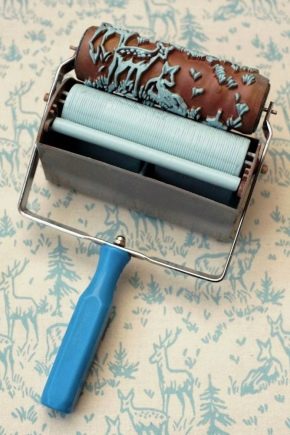
Textured surface finishing is one of the ways to personalize interior design. It is performed with special painting tools - textured and textured rollers, with which you can decorate the walls with art painting or create interesting decorative effects on them.



The quality of this type of finish depends on how carefully the base was prepared, the coating technology was followed and the roller itself was chosen correctly. Consider the varieties of relief painting tools and how to use them.
Application features
There are two ways to use a surface decorating roller.
- In the first case, it is used as a tool to stamp various patterns: from the simplest to the most complex fantasy ones, like when wallpaper is pasted, the canvases are joined together to continue the pattern. The roller can be pressed with varying force, resulting in a more or less pronounced relief.

- In the second case, using a rough roller or a tool with a patterned fur coat on the wall, they imitate the texture of various materials: brick, wood, marble or stone, and also make glazing - spectacular blurred spots.
To create a designer wall decoration, you can purchase a ready-made decorative roller or build it yourself. So that you can better navigate the assortment of textured painting tools, let's dwell on their varieties in more detail.

Views
The design of a standard roller includes a metal holder rod with a cylinder and a handle. Cylinder bases can be metal, plastic, rubber. Structural specimens with a pattern provide for a rotating cylinder that collects a dye composition, combined with a rubber nozzle, on the surface of which an ornament is carved to create impressions. The main difference between paint rollers is the coating of the cylinder.


Materials (edit)
Various materials are used for the manufacture of coatings for cylinders, depending on what it can be:
- Rubber or silicone with a variety of grooves and protrusions of various sizes, due to which a variety of decorative effects are created that imitate brickwork or a patterned relief.
- Foam, for whom it is convenient to work with water-based paints and paint small areas. Its disadvantages include poor painting of an uneven plane, the formation of splashes under intense pressure and fragility.

- Foam - This is a cheap analogue of a rubber roller. The disadvantage of foam is susceptibility to mechanical stress, so such a tool during operation will need to be repeatedly changed to a new one.
- Leather - with its help, you can achieve a very beautiful effect that imitates a marble coating. It is best to apply Venetian plaster with a natural leather roller, as it perfectly copes with this task.
- Wooden - since wood is an environmentally friendly material, it is advisable to use such rollers for decorating nurseries. They allow you to get a beautiful convex ornament on the surface treated with paint.



- Plastic - when using it, the decorative mixture will fall as it should only on an absolutely smooth surface, therefore, you cannot do without thorough preparation of the base. In addition, plastic is prone to cracking due to prolonged use.
- Fleecy (fur) - both natural and artificial fur can be used as a coating - polyacryl and polyamide, which have different lengths of fibers. The degree of roughness and the depth of patterned inclusions on the treated surface depends on the length of the threads.


Invoices
Decorative rollers are distinguished by a variety of structures, due to which the final ornaments are obtained. The purpose of some tools is to imitate the texture of natural materials, while others are to simply create an arbitrary pattern.
According to the method of application, they are:
- Textured products. Hard or soft rubber is used for their manufacture. When a wet plastered surface is rolled with such a tool, it acquires a relief. Using rollers with different patterns or just a rough cylinder, you can get the texture of a wide variety of materials from fur and wood to textiles and stone chips and even bamboo fiber. A fur coat provides the effect of multidirectional fibers, a rubber-coated roller allows you to simulate a natural stone, where a special looped pattern is cut, and after the spongy tool traces of bubbles remain.
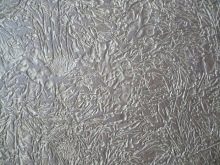


- Structural adaptations. With their help, a complex repeating ornament is applied to the plaster, for which a roller with a stencil is just intended. A feature of use is the application of a topcoat to an already finished surface, for example, a painted or evenly plastered wall. Decorating is started when the plane is completely dry. The most beautiful ornament is obtained if you use a curly roller with a certain pattern.

Effects
Decorative surface finishing offers endless possibilities for creativity. Of course, the easiest way for these purposes is to use ready-made textured design rollers that will become ideal assistants for creating all kinds of complex and very beautiful decorative effects:
- "Diagonal" is an unusual abstract pattern of oblique lines.
- "Blots" are picturesque spots with arbitrary outlines, reminiscent of spreading drops of liquid.
- "Rain" - despite the name given by the presence of chaotic lines and branches of the pattern on the cylinder, visually this effect looks like a bizarre floral pattern.





- "Frosty Morning" is an original ornament reminiscent of a pattern of frost that remains on the glass in winter in frosty weather.
- "Rhinestones" is a symmetrical ornament made of large imitations of precious stones arranged in rows.
- "Blooming Meadow" is a spectacular fantasy floral ornament.
No less beautiful effects are obtained when using rollers in combination with other decorative finishing tools. For example, to decorate the wall with a pretty polka-dot pattern, a standard roller is used together with a stencil - purchased or made yourself from thin plastic.
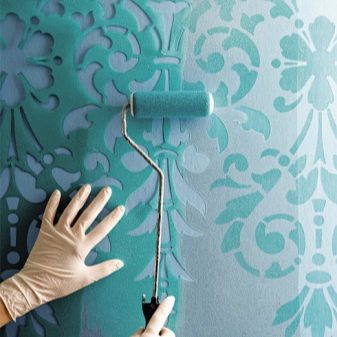
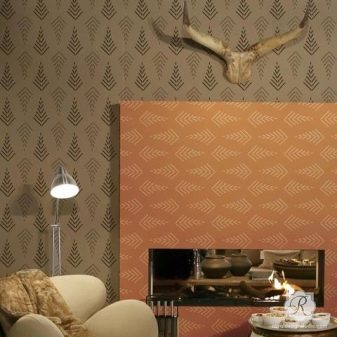
To create a bamboo effect, the base is covered with a white decorative mixture using a trowel. It is also used to form a background pattern. Until the base layer is dry, use a trowel or spatula to create a pattern that imitates bamboo shoots. Then the wall is treated with decorative wax using a paint roller. And at the end, dotted accents are placed with decorative silver varnish to give the drawing more expressiveness.
Glazing - blurred spots of deep shades, differing in saturation, are made by painting the wall with a basic color scheme and winding a chaotic pattern with a dry or wet cloth or cellophane.To create original textures, you can use a sponge that helps to create a soft spotted ornament or a brush for spectacular splashes.
An interesting effect is obtained from arbitrary prints on the wall of your own palms.


How to choose?
A variety of decorative painting tools can complicate roller selection. To avoid mistakes when buying, we suggest using the tips of the masters who have been engaged in decorative and finishing work for more than one year.
What should be done:
- Check the quality of the working part of the roller and its resistance to deformation. To do this, the fur coat must be crumpled noticeably, and then assess the condition. Severe dents on the fur coat are a reason to refuse to purchase such a roller.

- When choosing a long-haired roller, it is necessary to visually inspect the fur coat for loose fibers, which will necessarily stick to the painted wall, which looks unattractive.
- Make sure of the reliability of the clasp - the bracket that acts as the basis of the tool. Soft clasps deform faster, which not only shortens the service life of the roller, but also negatively affects the quality of the finish.
For painting walls, a product with a standard short handle is quite suitable, while for finishing the ceiling it is worth purchasing a tool with a special telescopic handle.

What to look for when buying:
- Structural rubber roller - in this case it is important to evaluate the quality of the rubber and the cylinder performance. A good tool has a resilient coating and an easily rolling, non-vibrating roller. The optimal solution for creating the perfect pattern is a tool that has a lubricating cylinder and a hopper, which allows you to stretch the entire pattern without the need to interrupt to saturate the coat with paint;
- A textured tool with a foam rubber coat - here you need to make sure that the selected spongy coating has pores of the required diameter to obtain a decorative effect of bursting bubbles or lunar craters;
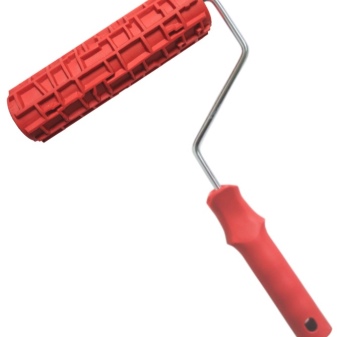

- Leather embossed roller - since it is used mainly for working with Venetian plaster, try to consider only those products for which the leather cover is natural. It is impossible to make prints on a plastered base with devices made of synthetic analogs - once, and they are capable of dissolving - two;
- Roller made of pile - here you need to be guided by the length of the villi, ranging from 0.2 cm to 2.5 cm. The effect of strong "furry" of the wall is created with a long-pile roller;
- Patterned tool - the drawing of a figured stamp is of great importance: the most beautiful ornaments are obtained through a combination of thin lines and bridges present in the pattern.



A stencil or texture roller can be purchased or made by hand. The usual painting tool is supplied with a homemade cloth, suede, paper or sponge coat, securely fixing it with threads. This device is good for applying chaotic spotted ornaments.
Surface preparation
Wall painting is the type of finishing work that everyone can master, the main thing is to prepare the surface with high quality. If you neglect the preliminary processing of the walls, then you can not count on the quality and durability of the finish.
Work order:
- Remove old coatings, such as wallpaper, from the surface.
- Smooth out irregularities on the plaster or concrete base with a sander.
- Prime the wall and seal cracks, sinks, chips with a plaster mixture.


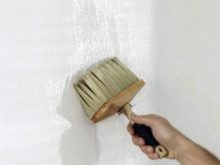
- Smooth the base with a finishing filler and sand.
- Dust the surface with a vacuum cleaner or herbal brush.
- Re-prime the substrate to increase adhesion to the decorative coating and reduce its consumption.
When the wall is completely dry, you can start decorating.
Paint application
It seems to many beginners who are just entering the world of repair that using a paint roller, given its elementary design, is as easy as shelling pears. Nevertheless, working with paints and varnishes (paintwork materials) requires some knowledge, without which an ideal finish, alas, is impossible.
So, first, the corners are painted with a brush or an angle roller. Paintwork materials are thoroughly mixed with a construction mixer at low power. Fill a ditch with paint and roll a roller in it with back and forth movements so that the coat properly picks up paintwork. At the end, a tool is carried out along the inclined corrugated base of the cuvette to remove excess coloring composition and its uniform distribution over the working part of the roller - a fur coat.

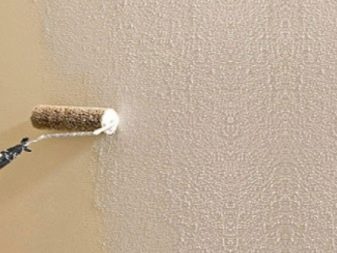
To determine the area of coverage of the working surface with the amount of paint that the roller has absorbed at a time, you need to roll out paintwork along the wall to get a square. In your mind, you need to break it into several strips, focusing on the width of the fur coat. Suppose we are dealing with five stripes.
Procedure:
- Apply a decorative coating from the top from the corner.
- Strip No. 1 is skipped: immediately, moving from bottom to top, strip No. 2 is painted over.
- Strip no. 3 is skipped, and strip no. 5 is also painted over from the bottom up, then no. 4, and after that strips no. 1 and no. 2.
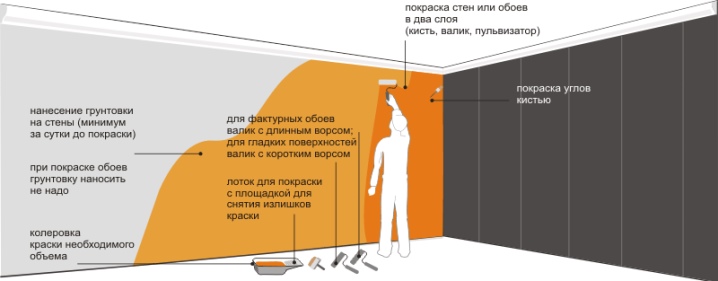
This method of painting contributes to the uniform distribution of the coloring composition and greatly facilitates the painting of the walls.
Then, moving with a roller from top to bottom, several horizontal stripes are drawn. Finishing to carry out each strip, the tool is necessarily torn off from the base. Two trips will ensure that the square is perfectly painted over.
Now all that remains is to type paintwork and, guided by this scheme, apply the paint further. The horizontal distribution of the coloring composition implies the capture of the previous square at a distance equal to the width of the working part of the roller.


Procedure for knurling a pattern with a pattern tool:
- The tray needs to be filled with paint to impregnate the foam part.
- Attach the structural rubber part of the roller and roll it several times over the corrugated base of the tray to remove excess paintwork material to prevent the formation of smudges.
- Pressing the roller to the working surface, they begin to form a pattern by laying a patterned path from top to bottom, reaching the edges of the base to be decorated.

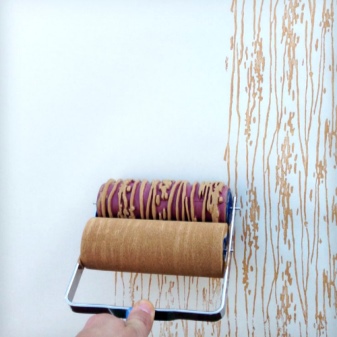
To create a second patterned track, the tool is applied clearly to the border of the first strip to ensure an even distribution of the pattern.
Care
Painting Tools - Brushes and rollers will last longer if properly cared for. At the end of work with water-dispersion paints, rinse the roller well enough under running water to rinse out the particles of the dye composition from the coat. Therefore, it is freed from the fur coat and washed, and a sponge or rag is used to clean the clasp and the handle. The washed brushes should be hung dry to prevent the bristles from breaking.

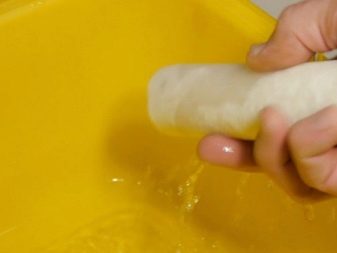
To work with various types of decorative coatings, you should take care of various removable coats. Such a solution allows you to reduce the cost of materials and finish in compliance with all the rules.
For information on how to apply paint with a textured roller, see this video.







The comment was sent successfully.